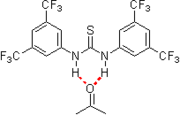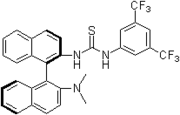(Thio)urea organocatalysis describes the utilization of properly designed derivatives of urea and thiourea to accelerate and stereochemically alter organic transformations through predominantly double hydrogen-bonding interactions with the respective substrate(s) (non-covalent organocatalysis). The scope of these small-molecule H-bond donors termed (thio)urea organocatalysts covers both non-stereoselective and stereoselective applications in organic synthesis (asymmetric organocatalysis).
In nature non-covalent interactions such as hydrogen bonding ("partial protonation") play a crucial role in enzyme catalysis that is characterized by selective substrate recognition (molecular recognition), substrate activation, and enormous acceleration and stereocontrol of organic transformations.
Based on the pioneering examinations by Kelly, Etter, Jorgensen, Hine, Curran, Göbel, and De Mendoza (see review articles cited below) on hydrogen bonding interactions of small, metal-free compounds with electron-rich binding sites Schreiner and co-workers performed series of theoretical and experimental systematic investigations towards the hydrogen-bonding ability of various thiourea derivatives.[1][2][3][4]
These purely organic compounds were found to reveal significant rate enhancements of simple Diels-Alder reaction, act like weak Lewis acid catalysts, but operate through explicit double hydrogen bonding instead of covalent (strong) binding known from traditional metal-ion mediated catalysis and Brønsted acid catalysis.
Overview
Schreiner and co-workers identified and introduced electron-poor thiourea derivatives as hydrogen-bonding organocatalysts. N,N'-bis[[3,5-bis(trifluormethyl)phenyl thiourea is to date the most effective achiral thiourea derivative and combines all typical structural features for double H-bonding mediated organocatalysis:
Advantages of thiourea organocatalysts:
- no product inhibition due to weak enthalpic binding, but specific binding-“recognition“
- low catalyst-loading (down to 0.001 mol%)[2]
- high TOF (Turn-Over-Frequency) values (up to 5,700 h−1)[2]
- simple and inexpensive synthesis from primary amine functionalized (chiral-pool) starting materials and isothiocyanates
- easy to modulate and to handle (bench-stable), no inert gas atmosphere required
- immobilization on a solid phase (polymer-bound organocatalysts), catalyst recovery and reusability [2]
- catalysis under almost neutral conditions (pka thiourea 21.0) and mild conditions, acid-sensitive substrates are tolerated
- metal-free, not toxic (compare traditional metal-containing Lewis-acid catalysts)
- water-tolerant, even catalytically effective in water or aqueous media
- environmentally benign ("Green Chemistry"), sustainable catalysts
To date various organic transformations are organocatalyzed through double hydrogen-bonding N,N'-bis[3,5-bis(trifluoromethyl)]phenyl thiourea at low catalyst loadings and in good to excellent product yields. This electron-poor thiourea derivative enjoys the status of being a privileged catalyst and represents the benchmark for the design of a broad variety of explicit double hydrogen-bonding (thio)urea organocatalysts - achiral, and chiral as well as monofunctional and bifunctional representatives:
Catalysts
Since 2001 research groups worldwide (e.g., Berkessel, Connon, Jacobsen, Nagaswa, Takemoto) have realized the potential of thiourea derivatives and developed various achiral/chiral mono- and bifunctional derivatives incorporating the electron-poor 3,5-bis(trifluoromethyl)phenyl substrate-"anchor" functionality. A broad variety of monofuctional and bifunctional (concept of bifunctionality) chiral double hydrogen-bonding (thio)urea organocatalysts have been developed to accelerate various synthetically useful organic transformations employing H-bond accepting substrates, e.g., carbonyl compounds, imines, nitroalkenes as the starting materials. The research towards the design and implementations of these catalysts in organic synthesis is still in the focus of interest.[5][6]
| 1998: Jacobsen's chiral (polymer-bound) Schiff base thiourea derivative for asymmetric Strecker reactions. [7][8] |
| 2001: Schreiner's N,N'-bis[3,5-bis(trifluoromethyl)phenyl thiourea: complexation of substrate through explicit double hydrogen-bonding, clamplike binding motif. [4][9] |
| 2003: Takemoto's bifunctional chiral thiourea derivative, catalysis of asymmetric Michael- and Aza-Henry reactions. [10] |
| 2005: Soos's, Connon and Dobson's bifunctional thiourea functionalized Cinchona alkaloid, asymmetric additions of nitroalkanes to chalcones
[15] as well as malonates to nitroalkenes [16] |
| 2006': Berkessel's chiral isophoronediamine-derived bisthiourea derivative, catalysis of asymmetric Morita-Baylis-Hillman reactions. [18] |
| 2006: Takemoto's PEG-bound chiral thiourea, asymmetric catalysis of (tandem-) Michael reactions of trans-β-nitrostyrene, aza-Henry reactions.[19] |
| 2007: Kotke/Schreiner, polystyrene-bound, recoverable and reusable thiourea derivative for organocatalytic tetrahydropyranylation of alcohols. [2] |
| 2007: Wanka/Schreiner, chiral peptidic adamantane-based thiourea, catalysis of Morita-Baylis-Hillman reactions. [3] |
| 2007: Ma Jun-An's Chiral Bifunctional Primary and tertiary Amine-thiourea Catalysts Based on Saccharides. [21][22] |
|
References
- ↑ Alexander Wittkopp, Peter R. Schreiner, "Diels-Alder Reactions in Water and in Hydrogen-Bonding Environments", book chapter in "The Chemistry of Dienes and Polyenes" Zvi Rappoport (Ed.), Volume 2, John Wiley & Sons Inc.; Chichester, 2000, 1029-1088. ISBN 0-471-72054-2.
Alexander Wittkopp, "Organocatalysis of Diels-Alder Reactions by Neutral Hydrogen Bond Donors in Organic and Aqueous Solvents", dissertation written in German, Universität Göttingen, 2001. english abstract/download:
A. Wittkopp and P. R. Schreiner (2003). "Metal-Free, Noncovalent Catalysis of Diels-Alder Reactions by Neutral Hydrogen Bond Donors in Organic Solvents and in Water". Chemistry: A European Journal. 9 (2): 407–414. doi:10.1002/chem.200390042. PMID 12532289.
Peter R. Schreiner, review: "Metal-free organocatalysis through explicit hydrogen bonding interactions", Chem. Soc. Rev. 2003, 32, 289-296. abstract/download:
M. Kotke and P. R. Schreiner (2006). "Acid-free, organocatalytic acetalization". Tetrahedron. 62 (2–3): 434–439. doi:10.1016/j.tet.2005.09.079.
Christian M. Kleiner, Peter R. Schreiner, "Hydrophobic amplification of noncovalent organocatalysis", Chem. Commun. 2006, 4315-4017.abstract/download:
Z. Zhang and P. R. Schreiner (2007). "Thiourea-Catalyzed Transfer Hydrogenation of Aldimines". Synlett. 2007 (9): 1455–1457. doi:10.1055/s-2007-980349.
M. P. Petri (2004). "Activation of Carbonyl Compounds by Double Hydrogen Bonding: An Emerging Tool in Asymmetric Catalysis". Angewandte Chemie International Edition. 43 (16): 2062–2064. doi:10.1002/anie.200301732. PMID 15083451.
Yoshiji Takemoto, review: "Recognition and activation by ureas and thioureas: stereoselective reactions using ureas and thioureas as hydrogen-bonding donors", Org. Biomol. Chem. 2005, 3, 4299-4306. abstract/download:
Mark S. Taylor, Eric N. Jacobsen (2006). "Asymmetric Catalysis by Chiral Hydrogen-Bond Donors". Angewandte Chemie International Edition. 45 (10): 1520–1543. doi:10.1002/anie.200503132. PMID 16491487.
J. C. Stephen (2006). "Organocatalysis Mediated by (Thio)urea Derivatives". Chemistry: A European Journal. 12 (21): 5418–5427. doi:10.1002/chem.200501076. PMID 16514689. - 1 2 3 4 5 Kotke, Mike; Peter Schreiner (2007). "Generally Applicable Organocatalytic Tetrahydropyranylation of Hydroxy Functionalities with Very Low Catalyst Loading". Synthesis. 2007 (5): 779–790. doi:10.1055/s-2007-965917. ISSN 0039-7881.
- 1 2 Wanka, Lukas; Chiara Cabrele; Maksims Vanejews; Peter R. Schreiner (2007). "γ-Aminoadamantanecarboxylic Acids Through Direct C–H Bond Amidations". European Journal of Organic Chemistry. 2007 (9): 1474–1490. doi:10.1002/ejoc.200600975. ISSN 1434-193X.
- 1 2 Schreiner, Peter R.; Alexander Wittkopp (2002). "H-Bonding Additives Act Like Lewis Acid Catalysts". Organic Letters. 4 (2): 217–220. doi:10.1021/ol017117s. ISSN 1523-7060. PMID 11796054.
- ↑ Kotke, Mike (Ph.D. 2009). Hydrogen-Bonding (Thio)urea Organocatalysts in Organic Synthesis : State of the art and Practical Methods for Acetalization, Tetrahydropyranylation, and Cooperative Epoxide Alcoholysis. University Giessen/Germany. Retrieved 2010-11-12.
- ↑ Kotke, Mike; Schreiner, Peter R. (October 2009). "(Thio)urea Organocatalysts". In Petri M. Pihko. Hydrogen Bonding in Organic Synthesis. pp. 141 to 251. ISBN 978-3-527-31895-7.
- ↑ Sigman, Matthew S.; Eric N. Jacobsen (1998). "Schiff Base Catalysts for the Asymmetric Strecker Reaction Identified and Optimized from Parallel Synthetic Libraries". Journal of the American Chemical Society. 120 (19): 4901–4902. doi:10.1021/ja980139y. ISSN 0002-7863.
- ↑ Sigman, Matthew S.; Petr Vachal; Eric N. Jacobsen (2000). "A General Catalyst for the Asymmetric Strecker Reaction". Angewandte Chemie International Edition. 39 (7): 1279–1281. doi:10.1002/(SICI)1521-3773(20000403)39:7<1279::AID-ANIE1279>3.0.CO;2-U. ISSN 1433-7851. PMID 10767031.
- ↑ Wittkopp, Alexander; Peter R. Schreiner (2003). "Metal-Free, Noncovalent Catalysis of Diels–Alder Reactions by Neutral Hydrogen Bond Donors in Organic Solvents and in Water". Chemistry: A European Journal. 9 (2): 407–414. doi:10.1002/chem.200390042. ISSN 0947-6539. PMID 12532289.
- ↑ Okino, Tomotaka; Yasutaka Hoashi; Yoshiji Takemoto (2003). "Enantioselective Michael Reaction of Malonates to Nitroolefins Catalyzed by Bifunctional Organocatalysts". Journal of the American Chemical Society. 125 (42): 12672–12673. doi:10.1021/ja036972z. ISSN 0002-7863. PMID 14558791.
- ↑ Sohtome, Yoshihiro; Aya Tanatani; Yuichi Hashimoto; Kazuo Nagasawa (2004). "Development of bis-thiourea-type organocatalyst for asymmetric Baylis–Hillman reaction☆". Tetrahedron Letters. 45 (29): 5589–5592. doi:10.1016/j.tetlet.2004.05.137. ISSN 0040-4039.
- ↑ Sohtome, Yoshihiro; Yuichi Hashimoto; Kazuo Nagasawa (2005). "Guanidine-Thiourea Bifunctional Organocatalyst for the Asymmetric Henry (Nitroaldol) Reaction". Advanced Synthesis & Catalysis. 347 (11–13): 1643–1648. doi:10.1002/adsc.200505148. ISSN 1615-4150.
- ↑ Herrera, Raquel P.; Valentina Sgarzani; Luca Bernardi; Alfredo Ricci (2005). "Catalytic Enantioselective Friedel-Crafts Alkylation of Indoles with Nitroalkenes by Using a Simple Thiourea Organocatalyst". Angewandte Chemie International Edition. 44 (40): 6576–6579. doi:10.1002/anie.200500227. ISSN 1433-7851. PMID 16172992.
- ↑ Wang, Jian; Hao Li; Xinhong Yu; Liansuo Zu; Wei Wang (2005). "Chiral Binaphthyl-Derived Amine-Thiourea Organocatalyst-Promoted Asymmetric Morita−Baylis−Hillman Reaction". Organic Letters. 7 (19): 4293–4296. doi:10.1021/ol051822+. ISSN 1523-7060. PMID 16146410.
- ↑ Vakulya, Benedek; Szilárd Varga; Antal Csámpai; Tibor Soós (2005). "Highly Enantioselective Conjugate Addition of Nitromethane to Chalcones Using Bifunctional Cinchona Organocatalysts". Organic Letters. 7 (10): 1967–1969. doi:10.1021/ol050431s. ISSN 1523-7060. PMID 15876031.
- ↑ McCooey, Séamus H.; Stephen J. Connon (2005). "Urea- and Thiourea-Substituted Cinchona Alkaloid Derivatives as Highly Efficient Bifunctional Organocatalysts for the Asymmetric Addition of Malonate to Nitroalkenes: Inversion of Configuration at C9 Dramatically Improves Catalyst Performance". Angewandte Chemie International Edition. 44 (39): 6367–6370. doi:10.1002/anie.200501721. ISSN 1433-7851. PMID 16136619.
- ↑ Cao, Chun-Li; Meng-Chun Ye; Xiu-Li Sun; Yong Tang (2006). "Pyrrolidine−Thiourea as a Bifunctional Organocatalyst: Highly Enantioselective Michael Addition of Cyclohexanone to Nitroolefins". Organic Letters. 8 (14): 2901–2904. doi:10.1021/ol060481c. ISSN 1523-7060. PMID 16805512.
- ↑ Berkessel, Albrecht; Katrin Roland; Jörg M. Neudörfl (2006). "Asymmetric Morita−Baylis−Hillman Reaction Catalyzed by Isophoronediamine-Derived Bis(thio)urea Organocatalysts". Organic Letters. 8 (19): 4195–4198. doi:10.1021/ol061298m. ISSN 1523-7060. PMID 16956185.
- ↑ Miyabe, Hideto; Sayo Tuchida; Masashige Yamauchi; Yoshiji Takemoto (2006). "Reaction of Nitroorganic Compounds Using Thiourea Catalysts Anchored to Polymer Support". Synthesis. 2006 (19): 3295–3300. doi:10.1055/s-2006-950196. ISSN 0039-7881.
- ↑ Yamaoka, Yousuke; Hideto Miyabe; Yoshiji Takemoto (2007). "Catalytic Enantioselective Petasis-Type Reaction of Quinolines Catalyzed by a Newly Designed Thiourea Catalyst". Journal of the American Chemical Society. 129 (21): 6686–6687. doi:10.1021/ja071470x. ISSN 0002-7863. PMID 17488015.
- ↑ Liu, Kun; Han-Feng Cui; Jing Nie; Ke-Yan Dong; Xiao-Juan Li; Jun-An Ma (2007). "Highly Enantioselective Michael Addition of Aromatic Ketones to Nitroolefins Promoted by Chiral Bifunctional Primary Amine-thiourea Catalysts Based on Saccharides". Organic Letters. 9 (5): 923–925. doi:10.1021/ol0701666. ISSN 1523-7060. PMID 17288432.
- ↑ Li, Xiao-Juan; Kun Liu; Hai Ma; Jing Nie; Jun-An Ma (2008). "Highly Enantioselective Michael Addition of Malonates to Nitroolefins Catalyzed by Chiral Bifunctional Tertiary Amine-Thioureas Based on Saccharides". Synlett. 2008 (20): 3242–3246. doi:10.1055/s-0028-1087370. ISSN 0936-5214.












